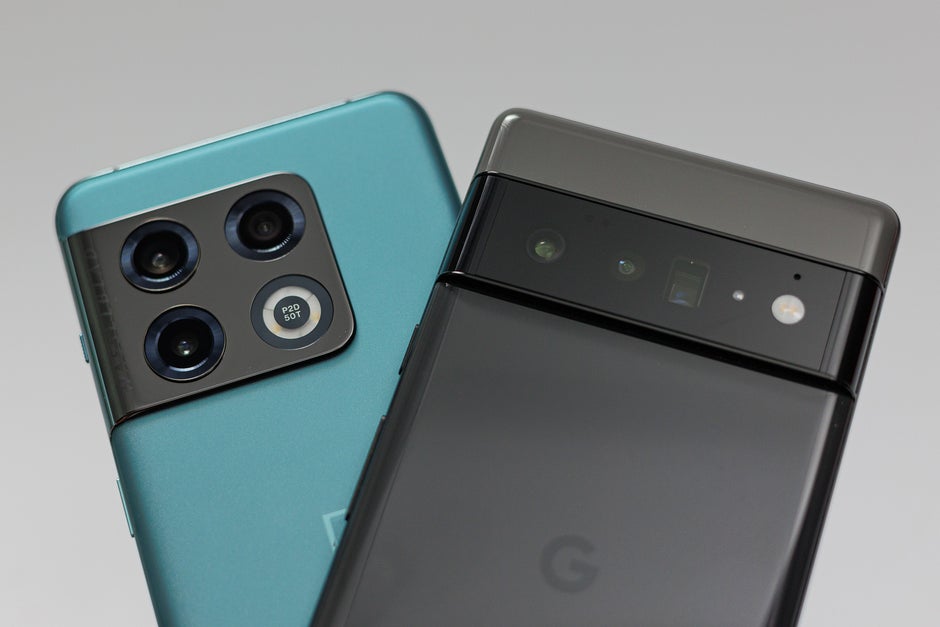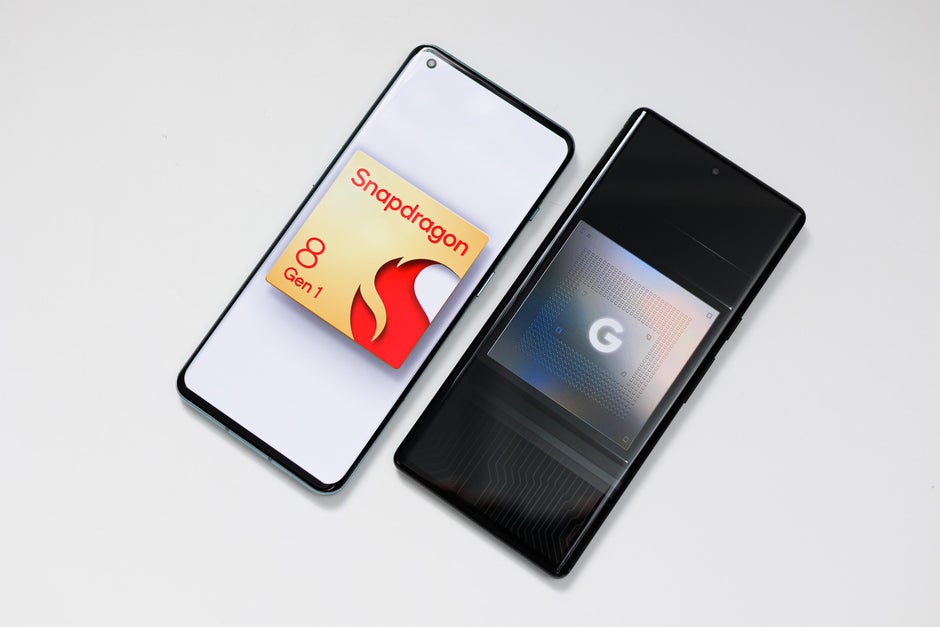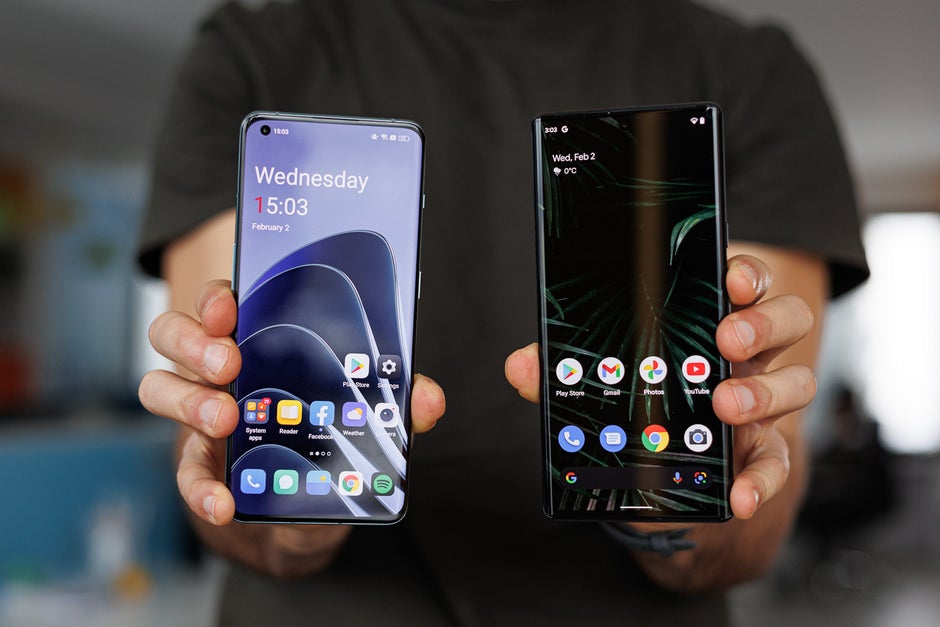OnePlus 10 Pro vs Google Pixel 6 Pro in a nutshell:
- 6.7″ screens, 120Hz Adaptive refresh rate
- Faster Snapdragon 8 Gen 1 chip on OnePlus
- No headphone jack or microSD cards on either one
- OnePlus features a bigger battery
- Pixel has longer zoom range
- OnePlus expected to cost a bit more
Also read:
Display and Design
Both look modern and trendy in their own way
These might just be two of the most distinct looking phones out there: the OnePlus with that large camera square overflowing into the frame of the phone, and then the Pixel with that Robocop-inspired horizontal camera bar.
Both are definitely big dogs, but the OnePlus is narrower, while the Pixel feels a bit bigger and less comfortable to grasp in one hand.
Neither phone features a headphone jack or a microSD card slot, a sign of the times surely.
With large 6.7-inch screens on both, you have plenty of screen real estate. Both are OLED panels with gorgeous colors and HDR support, and both support adaptive 120Hz refresh rate.
Display measurements and quality
Both also feature a punch hole front camera, but interestingly, the Pixel does not support face recognition to unlock your phone, while you have that useful option on the OnePlus. However, the main biometrics on both come in the form of an optical in-screen fingerprint scanner. So far, this is one of the sore points with the Pixel which is a bit slow and not super accurate, and we’ll be looking to compare the two once we get to test the OnePlus.
Battery and Charging
Pixel battery problems might be its biggest flaw
The other key category has got to be battery life, and here there is no difference between the pair as both the Pixel and the OnePlus sport a 5,000mAh battery.
That said, battery life is definitely weird on the Pixel, many users report abysmal battery life to the tune of less than 3 hours of screen time. Google has promised to fix issues with software updates, but so far, this is not a completely solved issue.
*OnePlus 10 Pro results: YouTube test was performed under default settings. Browsing and 3D Gaming tests were performed under “high performance” mode.
Another area where the OnePlus has a big advantage is charging. The 10 Pro features 80W fast charging and comes with a charger in the box, while the Pixel only supports up to 30W wired charging and does not have a charging brick included. This is a big deal, as the OnePlus is able to top up in just half an hour, while it takes about 1 hour and 45 minutes on the Pixel.
Both also support wireless charging, but again, OnePlus offers 50W speeds with its own proprietary charger (this one you buy separately), while Google only supports up to 23W speeds.
Cameras
One tough battle
Both phones come with a triple camera setup, with a wide, ultra-wide and a zoom lens. The Pixel actually has the longer zoom range with a 4X periscope style camera compared to a regular-style 3X zoom camera on the OnePlus. Here is a look at the camera specs:
| Camera Specs | Resolution | Sensor Size | Pixel Size | Lens |
|---|---|---|---|---|
| Main OnePlus | 48MP | 1/1.43″ | 1.12µm | 23mm, f/1.8 |
| Main Pixel | 50MP | 1/1.31″ | 1.12µm | 26mm, f/1.9 |
| Ultra OnePlus | 50MP | 1/2.76″ | 0.64µm | 14mm, f/2.2 |
| Ultra Pixel | 12MP | – | – | 18mm, f/2.2 |
| Tele OnePlus | 8MP | – | 1µm | 77mm (3.3X), f/2.4 |
| Tele Pixel | 48MP | 1/2″ | 0.8µm | 104mm (4X), f/3.5 |
The Pixel uses the larger sensor, but interestingly its ultra wide camera is actually not as “ultra” as you might expect with a narrower perspective (18mm vs 14mm on the OnePlus).
The OnePlus 10 Pro can certainly capture good looking photos, but you would notice how colors are often very bleak and pale, lacking in saturation, and there is a lingering problem with skin tones in the images above. The Pixel captures “juicier” photos that just have a bit more saturation and look more lively.
Also read:
While the OnePlus 10 Pro has tricks like 8K video recording and 4K120, which the Pixel does not have, it does not quite have as good video stabilization and it seems that it never uses the telephoto camera in video, resulting in poor video zoomed-in video recordings.
Front camera footage has nice sharpness and pleasing colors, but seems to have no proper video stabilization.
We might sound a bit harsh towards the OnePlus, but those are features a flagship, especially one with such ambitions, should have in 2022.
Performance and Storage differences
The newer OnePlus has the edge
The Pixel 6 Pro was not only a brand new design, it was the vessel for a brand new processor, the first mobile chip made by the company itself that goes by the name Google Tensor. It’s a solid first attempt, but not quite on par with the Snapdragon 8 Gen 1 inside the OnePlus 10 Pro that has faster performance in CPU and GPU benchmarks.
You get a noticeable jump in single-core performance, and a very slight increase in multi-core performance.
Both of these phones have clean interfaces that run fast, but the OnePlus seems to be a step ahead in perceived zippiness.
On the network side, you have 5G connectivity on both phones.
Interestingly, the Pixel ships with 128GB of storage in the base model, or you can buy a 256GB version for $100 more, while the OnePlus is expected to have 256GB of storage in the base model. There is no microSD card support on either one, hardly a surprise considering the history of these two companies’ flagships.
OnePlus 10 Pro vs Google Pixel 6 Pro: Specs Comparison
And here is a detailed specs comparison between the OnePlus 10 Pro and the Google Pixel 6 Pro:





